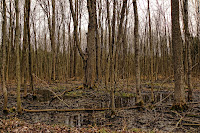My friend and I have decided to tackle an end-to-end hike of the Bruce Trail. Not in order, and certainly not to any deadline ... we just want to explore the whole path.
We decided to start on the Iroquoia section in the Burlington/Hamilton area on St.Patrick's Day. We dropped off her car on 1st Sideroad just east of Guelph Line and then continued on, through the village of Waterdown, and parked my car where the Bruce trail crosses Highway 6 just south of Dundas.
The weather was cool and foggy but the weather report said the fog would burn off by mid-morning and the sun would come out. The trail starts by heading through a tunnel under Highway 6 and climbs up a set of concrete steps to the trail proper. We were almost immediately greeted by an old homestead that is now used by teenagers as party central. There is a lot of garbage and some graffiti that detracts from the ruins. The trail then follows undulating terrain across the side of the escarpment before eventually climbing to the top and skirting a reclaimed quarry.
|
|
 |
| Misty morning. |
|
The trail re-enters the forest here and the terrain becomes very rocky. There are an abundance of local trails that criss-cross the path. The route then descends to cross a small creek and then a set of train tracks before emerging onto Snake Road 2.8km from where we started.
The trail climbs again before passing a farmer's field and a marsh, it then quickly descends to travel south alongside Grindstone Creek. After crossing a bridge over the Grindstone the most technical, and also the most beautiful section of the trail begins. The path follows the fast flowing creek for almost 2km with many sharp elevation changes over rocky and root-riddled terrain. Make sure your camera is ready in this section.
The trail emerges, at km 6.3, on Waterdown Road (also called Mill St.) There is a parking area here and a viewing platform of a medium sized waterfall (which is called, depending on the source, Waterdown Falls, Great Falls, or Grindstone Falls).
 |
| Grindstone Creek |
|
 |
| Grindstone Creek |
|
The path then climbs a steep embankment, crosses the road, and goes through a grassy right of way before emerging into a subdivision. After about 400m of road travel the trail climbs a stile and returns to the forest. This section remains relatively flat with minor elevation changes before crossing King Rd at km 9.2.
There are some great views to be had in this section of Burlington and even of Toronto if the weather is cooperative. After emerging onto Kerns Road at km 10.9 the trail enters Kernscliff Park, this is an old quarry that is being converted into a park by the City of Burlington. The path descends into a valley before climbing back up and follows a grassy path across the top of the escarpment before entering the forest once more. We stopped here for a rest, to have a snack and to take off our top layers (the weather, and the climb had warmed us). We met a group of 3 older ladies who were out hiking with their black Lab puppy. They told us that it was all downhill from here to Guelph Line .... yeah .... it's not. Although we had done most of our climbing up to this point (almost 220m ... or 722 ft), there was still almost 130m of climbing ahead of us.
The trail then veers north and crosses Dundas Street at km 12.6. There are many black capped chickadees in this section but we couldn't get any to feed from our hands. The trail has minor elevation changes and travels in a NE direction until coming out into Cedar Springs Road at km 13.6. The path follows the road south for about 100m before climbing a stile and re-entering the forest.
This next section can get quite muddy and waterproof footwear is recommended in the spring or after a decent rainfall. The trail goes through some private property, passing a large house before coming across a small pond at the base of a cliff face. The path climbs steeply up to the top and follows a muddy path between farmer's fields and eventually comes out at a nice view of Fisher's Pond at km 15.8.
More muddy paths between farmer's fields follows before entering a forest and descending quickly to a small litter-strewn creek. We crossed the creek twice, climbed out of the valley and eventually come out onto Guelph Line at km 18.
The final section follows a farmer's field for roughly 400m before crossing into a forest. This is fairly level and led us to 1st Sideroad and the end of our hike. In total it was 20.5km (which includes detours to lookouts and geocaching) and our total time was 6:33. Climbing total was 347m (1,138 ft) ... the equivalent of climbing the top of a 105 story building.












































.jpg)
.jpg)



